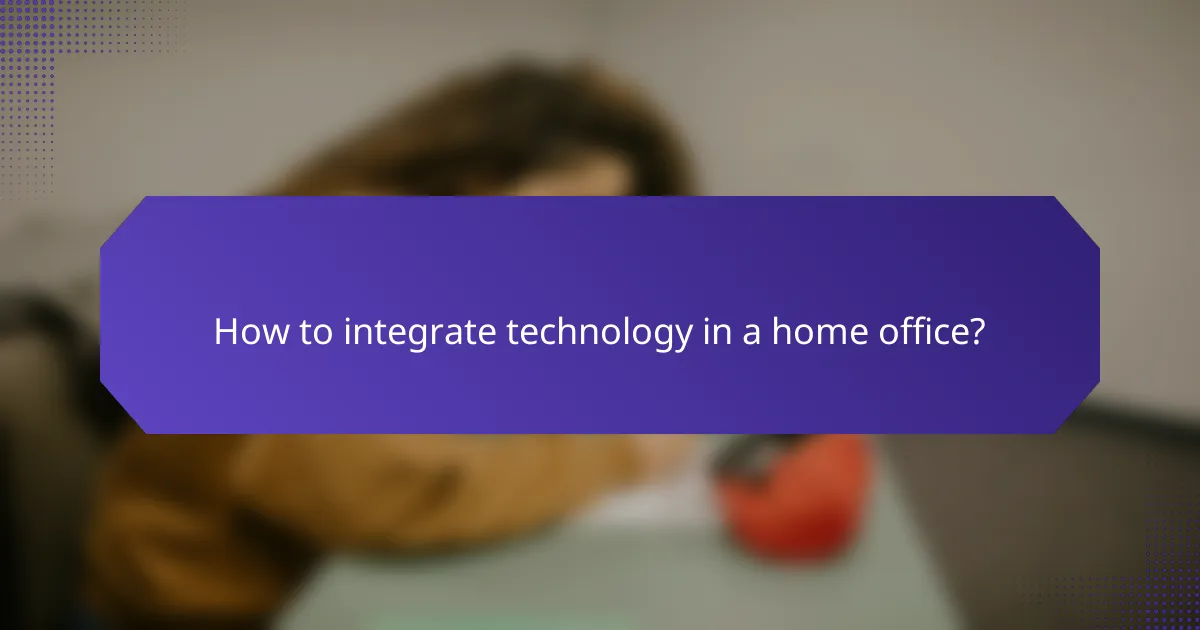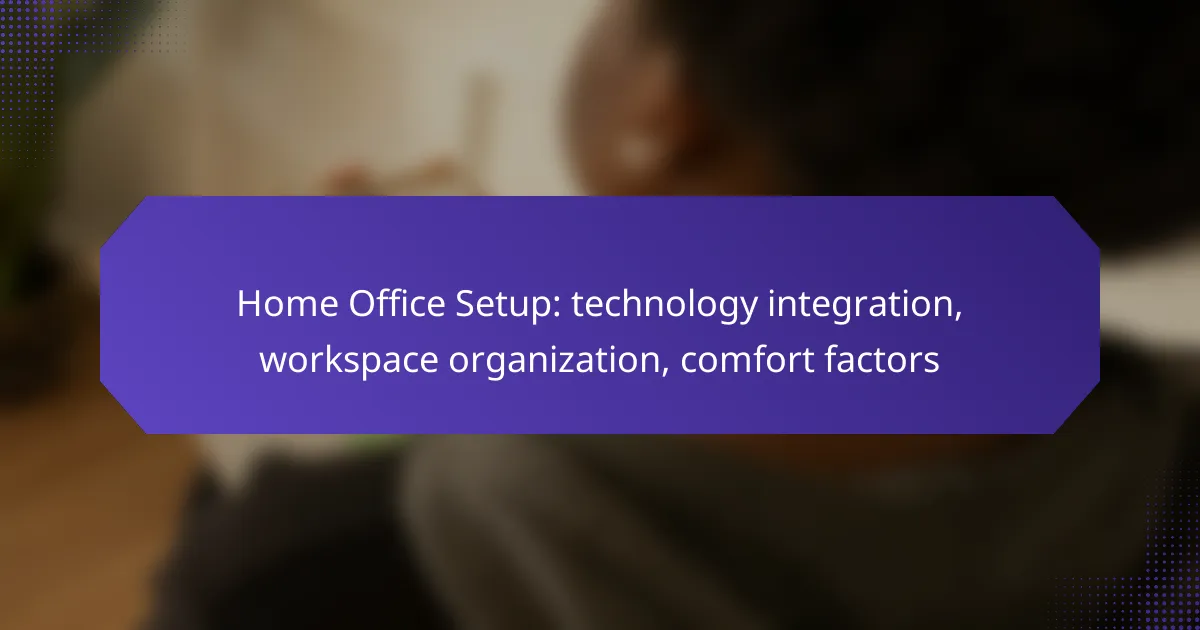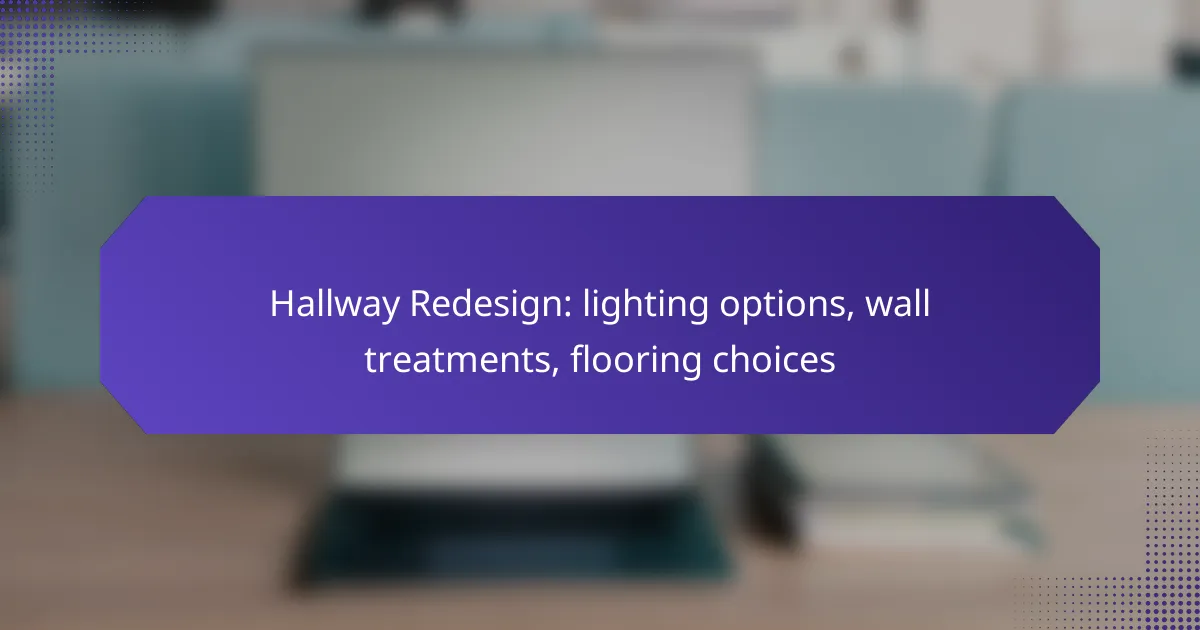Creating an effective home office setup requires a thoughtful integration of technology, workspace organization, and comfort factors. By selecting smart devices and ergonomic solutions, you can enhance productivity while ensuring a comfortable environment. Additionally, organizing your workspace with modular shelving and digital tools can streamline your workflow and reduce stress.

How to integrate technology in a home office?
Integrating technology in a home office involves selecting tools and systems that enhance productivity and comfort. Focus on smart devices, ergonomic solutions, and reliable connectivity to create an efficient workspace.
Smart lighting systems
Smart lighting systems allow you to control the brightness and color of your workspace with ease, often through smartphone apps or voice commands. Consider options that adjust automatically based on the time of day to reduce eye strain and improve focus.
Look for systems compatible with existing smart home devices, ensuring seamless integration. Brands like Philips Hue or LIFX offer customizable settings that can enhance your work environment significantly.
Ergonomic furniture with built-in tech
Ergonomic furniture, such as adjustable desks and chairs, can greatly improve comfort during long work hours. Some models come with built-in technology like USB ports and wireless charging pads, adding convenience to your setup.
When selecting ergonomic furniture, prioritize features that promote good posture and reduce fatigue. Brands like Herman Miller and Steelcase offer a range of options tailored for home offices.
High-speed internet solutions
Reliable, high-speed internet is crucial for effective remote work. Consider fiber-optic connections or cable internet plans that offer speeds of at least 100 Mbps for smooth video conferencing and quick downloads.
Evaluate local providers and compare plans based on speed, reliability, and customer service. Investing in a good router can also enhance your network’s performance, especially in larger homes.
Noise-canceling headphones
Noise-canceling headphones can significantly improve concentration by blocking out distractions. Look for models that provide active noise cancellation and comfortable fit for extended use.
Popular brands like Bose and Sony offer options that cater to various budgets, with battery life ranging from 20 to 30 hours. Test headphones before purchasing to ensure they meet your comfort and sound quality preferences.
Collaboration tools like Zoom and Slack
Collaboration tools such as Zoom and Slack facilitate communication and teamwork in a remote setting. Zoom is ideal for video meetings, while Slack offers a platform for messaging and file sharing.
Explore features like screen sharing and integrations with other apps to maximize productivity. Ensure your team is trained on these tools to enhance collaboration and streamline workflows.

What are the best workspace organization tips?
Effective workspace organization enhances productivity and reduces stress. Key strategies include using modular shelving, desk organizers, digital tools, and labeling systems to create a streamlined and efficient work environment.
Use of modular shelving units
Modular shelving units allow for flexible storage solutions that can adapt to your changing needs. They can be configured in various ways to maximize vertical space, making them ideal for small home offices.
Consider incorporating shelves that can hold books, files, and decorative items. This not only keeps your workspace tidy but also adds a personal touch to your environment.
Desk organizers for cables and supplies
Desk organizers help manage cables and office supplies, reducing clutter and distractions. Look for organizers that can hold pens, notepads, and other essentials within arm’s reach.
Utilizing cable management solutions, such as clips and sleeves, can keep cords tidy and prevent tangling. This simple adjustment can significantly improve the aesthetic and functionality of your workspace.
Digital task management tools
Digital task management tools streamline project tracking and enhance productivity. Applications like Trello, Asana, or Todoist allow you to organize tasks, set deadlines, and collaborate with others seamlessly.
Choose a tool that fits your workflow and integrates well with other software you use. Many of these tools offer free versions, making them accessible for any budget.
Labeling systems for documents
Implementing a labeling system for documents ensures easy retrieval and organization. Use clear, consistent labels for physical files and digital folders to minimize time spent searching for important materials.
Consider color-coding labels or using a numbering system to categorize documents effectively. This approach can enhance efficiency, especially when dealing with multiple projects or clients.

How to enhance comfort in a home office?
Enhancing comfort in a home office involves selecting ergonomic furniture, ensuring proper climate control, and personalizing the workspace. These factors contribute to better productivity and overall well-being during work hours.
Adjustable standing desks
Adjustable standing desks allow users to switch between sitting and standing positions, promoting better posture and reducing fatigue. Look for models that offer a height range suitable for your body type, typically between 25 to 50 inches.
Consider features like programmable height presets and stability when fully extended. Investing in a quality standing desk can significantly improve your comfort and energy levels throughout the day.
Quality office chairs
A quality office chair is essential for comfort during long hours of work. Look for chairs with adjustable height, lumbar support, and breathable materials to prevent discomfort and promote good posture.
Models that allow for tilt and armrest adjustments can further enhance comfort. Aim for chairs that meet ergonomic standards to ensure they support your body properly.
Climate control solutions
Maintaining a comfortable temperature is crucial for productivity in a home office. Consider using fans, space heaters, or air conditioning to keep the workspace at a comfortable level, typically between 20 to 22 degrees Celsius.
Additionally, using air purifiers can improve air quality, which is beneficial for overall comfort and health. Regularly check and adjust your climate control settings to suit seasonal changes.
Personalized decor for motivation
Personalized decor can enhance motivation and create a welcoming atmosphere in your home office. Choose artwork, plants, or personal items that inspire you and reflect your personality.
Consider incorporating color psychology; for instance, blues and greens can promote calmness, while yellows may boost creativity. A well-decorated space can make your work environment more enjoyable and stimulating.

What are the essential equipment for a home office?
Essential equipment for a home office includes high-resolution monitors, reliable printers and scanners, and webcams for video conferencing. These tools enhance productivity, facilitate communication, and support various tasks required for remote work.
High-resolution monitors
High-resolution monitors are crucial for a comfortable and efficient workspace. They provide clearer images and text, reducing eye strain during long hours of work. Look for monitors with at least Full HD (1920 x 1080) resolution, though 4K (3840 x 2160) is becoming more common for detailed tasks.
Consider the size of the monitor as well; a screen between 24 to 32 inches is typically ideal for multitasking. Dual-monitor setups can further enhance productivity by allowing you to view multiple applications simultaneously.
Reliable printers and scanners
Reliable printers and scanners are essential for handling documents and paperwork efficiently. Choose an all-in-one printer that offers printing, scanning, and copying capabilities to save space and reduce costs. Look for models that support wireless connectivity for easy access from multiple devices.
When selecting a printer, consider the cost of ink or toner and the speed of printing. Inkjet printers are generally suitable for color documents, while laser printers are preferred for high-volume black-and-white printing.
Webcams for video conferencing
Webcams are vital for effective communication in a remote work environment. A good quality webcam should offer at least 720p resolution, but 1080p is preferable for clearer video during meetings. Ensure the webcam has a built-in microphone to simplify setup and improve audio quality.
When purchasing a webcam, check for features like autofocus and low-light correction, which can enhance video quality in various lighting conditions. Position the webcam at eye level to create a more natural and engaging video call experience.

How to choose the right technology for remote work?
Selecting the right technology for remote work involves assessing both software and hardware needs to ensure a seamless workflow. Prioritize tools that enhance productivity, facilitate communication, and are compatible with your existing systems.
Assessing software compatibility
When evaluating software for remote work, ensure that it integrates well with your current applications and systems. Look for tools that support collaboration, such as video conferencing platforms, project management software, and cloud storage solutions.
Check for compatibility with operating systems and devices you use. For instance, if your team relies on Windows, ensure that any software you consider is optimized for that environment. Additionally, consider security features, as data protection is crucial when working remotely.
Evaluating hardware requirements
Your hardware setup is just as important as your software. Assess the specifications needed for your tasks, such as processor speed, RAM, and storage capacity. For most remote work, a computer with at least 8GB of RAM and a modern processor will suffice.
Consider peripherals that enhance comfort and productivity, such as ergonomic keyboards, high-resolution monitors, and reliable webcams. Investing in quality hardware can reduce strain and improve your overall work experience. Don’t forget to check your internet connection speed, aiming for at least 25 Mbps for smooth video calls and file transfers.

What are the local regulations for home office setups?
Local regulations for home office setups vary widely by region and may include zoning laws, safety codes, and tax implications. It’s essential to check with local authorities to ensure compliance with any specific requirements that may apply to your home office.
Technology Integration
Integrating technology into your home office is crucial for productivity and efficiency. Consider using reliable internet connections, ergonomic devices, and software that enhances collaboration, such as video conferencing tools and project management applications.
When selecting technology, prioritize devices that meet your work needs. For instance, a high-speed internet connection is essential for remote meetings, while a good quality headset can improve audio clarity. Evaluate options based on your budget, typically ranging from a few hundred to several thousand dollars depending on your requirements.
Workspace Organization
Effective workspace organization enhances focus and reduces distractions. Start by decluttering your desk and utilizing storage solutions like shelves, filing cabinets, or desk organizers to keep essential items within reach.
Consider the layout of your home office. Position your desk to take advantage of natural light and ensure that your computer screen is at eye level to prevent strain. A well-organized workspace can improve your workflow and increase productivity significantly.
Comfort Factors
Comfort is vital for long hours of work in a home office. Invest in an ergonomic chair and desk that support good posture, as well as accessories like footrests or keyboard trays to enhance your comfort level.
Temperature control is another important factor. Aim to keep your workspace at a comfortable temperature, typically between 20-22°C (68-72°F). Adding plants or personal touches can also create a more inviting atmosphere, contributing to your overall well-being while working from home.










